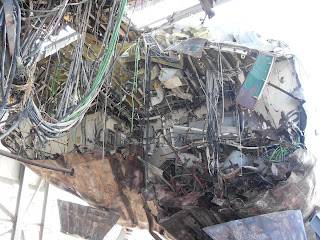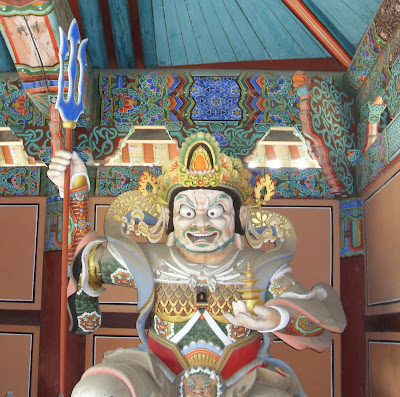Our journey began, as many do, at a bus stop, haha. This trip was to be a lesson in traveler's patience. The express bus took the expected hour to arrive at the station in Seoul from which we departed further North using the subway system, for another 35 minutes. Upon arrival, I was foolishly expecting the park entrance to be within a mile of the station, easily within walking distance. Well, I was wrong. We still needed to take another bus, about 20 minutes up the road, which is still reasonable....except that we were apparently not the only pair who thought it would be a great weekend to get out. I present the bus line:
Ummm, so at the risk of hyperbole, the line was INSANELY long! Persevere we did, however, and with little complaint or grumbling I might add, hehe. In all actuality, for such a long line, it moved rather quickly, and after about an hour we were on the last leg of the journey there. An interesting note was how nice the town just before the park was. It looked like mostly new construction, and very clean and organized. They even had a Coldstone Creamery!
By early afternoon we had finally arrived.
 The area just outside the park entrance was well developed with all manner of outdoor clothing shops, recreational gear vendors, hotels and of course restaurants. One item of note was the abundance of Kimbap. This is very similar to Japanese maki rolls, but in most cases, contains no seafood, rather cooked egg and sausage or spam in addition to various vegetables. I came to understand that this was the preferred traditional hiking food, as it keeps well, is full of carbs, and packs easily. To my great pleasure, as we were ready to hit the trails, Mr. Pae told me that his wife had prepared some for us as lunch, and we indulged. I have to commend her preparation. The rice was perfect, and the combination of pickled radish and sausage (similar to a small diameter mild peperoni) was delicious!
The area just outside the park entrance was well developed with all manner of outdoor clothing shops, recreational gear vendors, hotels and of course restaurants. One item of note was the abundance of Kimbap. This is very similar to Japanese maki rolls, but in most cases, contains no seafood, rather cooked egg and sausage or spam in addition to various vegetables. I came to understand that this was the preferred traditional hiking food, as it keeps well, is full of carbs, and packs easily. To my great pleasure, as we were ready to hit the trails, Mr. Pae told me that his wife had prepared some for us as lunch, and we indulged. I have to commend her preparation. The rice was perfect, and the combination of pickled radish and sausage (similar to a small diameter mild peperoni) was delicious!
Map of Bukhansan
This was the first time I encountered this particular solution to cold weather cycling...Tonya take note, hehe!
Happily satiated, we started on our trek to conquer the mountain, which began with a quaint trail along a beautiful boulder strewn trickling stream. After a ways, the easy trail brought us to a rest area and very small temple. This also happened to be a major crossroad for the various routes through the park. Since it was already early afternoon we decided for the shortest path to the top of the park's namesake, and put the temple behind us at an eager pace. However, whereas the first leg of the journey was gentle and languid, this path proved to be steep and treacherous, utilizing root, stone and loose leaves and gravel to making footing uneasy, and near vertical crevasses to bring all but mad men to a crawl. We would not be deterred. In fact, we both fell prey to the most classic of masculine vices; pride. Neither of us would be outdone in speed of ascension, and so we drove up the mountain at astounding speed, heaving with breath and dripping with sweat, and bewildering the multitude of Koreans enjoying a leisurely stroll in the park, complete with picnics including beer and soju! It was not long before the reality struck that we are, in fact, not supermen, and would require several breaks along the way, and we were better for it physically and spiritually, for it afforded us a chance to really take in some of the hidden beauties of the park, such as this hidden engraving of a poem. As well as some spectacular tumbles of limestone.
 After about two hours from the crossroads, we reached the bare rock and final assent to the peak. The view from the knobs of stone, a mere 3,000 ft compared to our Rocky Mountain standards of 10-14,000, still felt like the top of the world. We decided to content ourselves with these lower peaks because the crowds to the very top were just too thick, and not worth the frustration. We spent some time here admiring the vistas as well as a pair of birds of prey hunting from the cliffs below. After some time the wind changed and a cold crept into the air, and we departed with the same gusto we climbed, and really had a blast getting lost in the adventure of the decent.
After about two hours from the crossroads, we reached the bare rock and final assent to the peak. The view from the knobs of stone, a mere 3,000 ft compared to our Rocky Mountain standards of 10-14,000, still felt like the top of the world. We decided to content ourselves with these lower peaks because the crowds to the very top were just too thick, and not worth the frustration. We spent some time here admiring the vistas as well as a pair of birds of prey hunting from the cliffs below. After some time the wind changed and a cold crept into the air, and we departed with the same gusto we climbed, and really had a blast getting lost in the adventure of the decent.
Outside the park, the bus line was just as long as when we arrived, but now that we knew the way, we chose to walk back to the Metro instead. It took us about 45 minutes, but that was less than the wait for a 20 minute bus, so we considered ourselves the victors, hehe. It was not until I sat down on the bus 30 minutes later that the exhaustion hit me. I barely had the strength to devour a delicious persimmon that Mr. Pae produced as we took our seats, before duly passing out, completed with contented snores and dreamless sleep. It was a fantastic hike, and one I am deeply in debt to Mr. Pae for indulging me! Hopefully I will have an opportunity soon to return the favor.
Still to come, a visit to hot springs and Jimjilbang culture...






















































